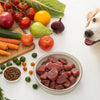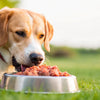Is It Ok to Cook Raw Dog Food? Understanding the Benefits and Risks
- Houndsy
Table of Contents
- Introduction
- The Raw Dog Food Movement
- Exploring the Cooking Dilemma
- Reasons for Cooking Raw Dog Food
- Cooking Methods and Their Effects
- The Risks of Cooking Raw Bones
- Alternatives to Cooking Raw Dog Food
- Conclusion
Introduction
Imagine the joy of preparing a delicious meal for your furry friend, only to question whether the cooking process might undermine the nutritional value of the food you’re serving. This dilemma is one many dog owners grapple with, especially as raw feeding gains popularity among pet parents. Recent studies indicate that more than 10% of dog owners are now opting for raw dog food, with an increasing number of those worried about food safety. As we explore the question of whether it’s okay to cook raw dog food, we will delve into the unique complexities surrounding pet nutrition and health.
In this blog post, we intend to provide clear insights into cooking raw dog food, explore its advantages and disadvantages, and address the underlying concerns driving pet owners to consider this option. By the end, you will have a comprehensive understanding of how cooking can impact your dog's diet, along with considerations that may help you make informed decisions about your pet's nutrition.
We invite you to reflect on your current feeding practices and your motivations for either continuing a raw diet or transitioning to a cooked approach. Our main thesis is simple yet profound: while it is technically possible to cook raw dog food, it’s important to recognize the nutritional implications and potential risks involved.
The Raw Dog Food Movement
The shift toward raw feeding has its roots in the desire to provide dogs with a diet that closely resembles what their wild counterparts would consume. Raw dog food typically consists of raw meat, bones, fruits, and vegetables, designed to offer a complete nutrient profile. Advocates argue that such a diet is inherently healthier, promoting benefits such as improved digestion, healthier skin and coat, and enhanced overall vitality.
The Benefits of Raw Feeding
- Nutritional Integrity: Raw dog food preserves the natural enzymes and vitamins that cooking can destroy. This ensures that your dog receives the full spectrum of nutrients they need to thrive.
- Improved Digestion: Many pet owners report that their dogs experience fewer digestive problems while on a raw diet, often showing less bloating and firmer stools.
- Dental Health: Chewing on raw bones can help maintain dental hygiene by naturally cleaning teeth and stimulating gums.
While these benefits have made raw feeding increasingly popular, concerns about foodborne pathogens and proper handling remain significant. This leads many owners to question whether cooking can mitigate these risks.
Exploring the Cooking Dilemma
Is It Safe to Cook Raw Dog Food?
The short answer is yes, it is technically safe to cook raw dog food. However, this practice alters the food’s nutritional properties. Dogs, like their wild ancestors, are biologically designed to process raw food effectively. Cooking can damage the very nutrients, enzymes, and natural compounds that contribute to the health benefits associated with a raw diet.
Nutritional Changes During Cooking
Cooking can dramatically change the nutrient profile of dog food:
- Loss of Nutrients: Cooking can lead to the loss of essential vitamins (especially B vitamins) and enzymes that aid digestion and nutrient absorption. Studies indicate that cooking can reduce the bioavailability of certain minerals, such as calcium, zinc, and iron.
- Denaturation of Proteins: While cooking can make proteins more digestible, it can also change their structure, potentially reducing their amino acid values.
Understanding these changes can assist you in determining whether the benefits of cooking outweigh the drawbacks.
Reasons for Cooking Raw Dog Food
-
Concern for Pathogens: Some owners worry about bacteria such as Salmonella and E. coli, which can be present in raw meat. Cooking can eliminate these concerns as it kills harmful bacteria—however, it’s essential to note that dogs have a different digestive system from humans. Their stomach acids and shorter digestive tracts are well-equipped to handle pathogens found in raw meats.
-
Picky Eaters: Some dogs may simply prefer the taste and aroma of cooked food over raw. While raw feeding purists often insist that dogs can adapt to raw diets, others find success by lightly cooking their dog's meals.
-
Health Issues: For dogs with specific health conditions, such as gastrointestinal sensitivities, cooked diets can provide easier digestibility and a gentler option.
Thus, while cooking raw food may address specific concerns, it is vital to consider how it affects overall nutrition.
Cooking Methods and Their Effects
If you choose to cook dog food, doing so gently is crucial to maintain as much nutritional integrity as possible. Here are several cooking methods commonly used for raw dog food and their implications:
1. Sautéing
This quick cooking method involves stirring raw ingredients in a pan with a small amount of liquid (broth or water) over low heat for a short duration. Sautéing minimizes nutrient loss while providing a cooked texture some dogs enjoy.
- Best Practices: Aim for a cooking time of about 3-5 minutes, just enough to warm the food and ensure safety.
2. Baking
Baking can also be an option, but it requires careful regulation of temperature to avoid overcooking.
- Best Practices: Preheat the oven to a moderate temperature (around 350°F) and bake for a shorter period, focusing on moisture retention by covering the food.
3. Sous Vide
This technique involves sealing food in an airtight bag, then cooking it in a water bath at precise temperatures, allowing for even cooking without significant nutrient loss.
- Best Practices: Cook within safe bacterial growth temperatures (140°F for proteins) while maximizing nutrient retention.
4. Avoid Microwaving
While it may be tempting to heat food quickly in the microwave, microwaving is not recommended. It heats unevenly, leading to hotspots that can degrade nutrients and the risk of creating dry, unpalatable meals.
Understanding these methods can significantly impact your decision-making regarding your pet's diet and overall well-being.
The Risks of Cooking Raw Bones
One of the most critical considerations when debating whether to cook raw dog food is the treatment of bones. Cooking transforms bones, making them brittle and likely to splinter.
Why Raw Bones Are Important
- Safer for Chewing: Raw bones are softer and more digestible, providing dental benefits while minimizing the dangers associated with sharp splinters.
- Nutritional Value: Raw bones are rich in calcium and phosphorus, aligning with a dog’s natural diet and meeting essential nutrient needs.
What Happens to Cooked Bones?
- Increased Risk of Injury: As mentioned, when bones are cooked, they become hazardous, leading to potential choking, blockages, or perforations in the gastrointestinal tract. Therefore, if you choose to feed raw bones, always keep them raw!
By understanding the implications of cooking bones, pet owners can make more informed choices about their dog's diet.
Alternatives to Cooking Raw Dog Food
As outlined, while there are valid reasons for considering the cooking of raw dog food, alternative approaches can help address health concerns while retaining the benefits of raw feeding.
High-Quality Raw Food Brands
Some companies specialize in creating balanced raw dog food diets that are safely sourced and tested for pathogens. These products allow you to enjoy the benefits of a raw diet without the need for cooking.
Balanced Nutrition
Consider opting for pre-packaged raw diets that are carefully formulated to meet your dog's nutritional needs. These diets often incorporate high-quality ingredients that are both safe and effective.
Consulting with a Veterinarian
When in doubt about transitioning your dog’s diet or adapting to cooking raw food, consider consulting your veterinarian or a pet nutritionist. Their insights can guide you in finding the best solution.
Conclusion
In summary, the question of whether it is okay to cook raw dog food warrants careful consideration. While it is possible to cook raw ingredients, many of the health benefits associated with a raw diet can be diminished through cooking. Cooking may address certain concerns, such as picky eating and pathogen risks, but it can also lead to nutritional losses and hazards regarding cooked bones.
By understanding the implications and risks associated with cooking raw dog food, pet owners can tailor their feeding approaches to best suit their pet's needs. For those of us at Houndsy, we believe in enhancing the feeding experience for both pets and owners. As you explore options for feeding your furry companion, consider trying the Houndsy Kibble Dispenser to simplify the feeding process and ensure optimal portion control!
FAQ
Is it safe for dogs to eat cooked bones?
No, cooked bones can become brittle and pose a choking hazard or cause internal injuries. Always opt for raw bones if you choose to incorporate them.
Do dogs really need to consume raw food?
While dogs can thrive on a variety of diets, raw food aligns more closely with their evolutionary dietary needs. Raw diets often lead to benefits, such as improved digestion and coat health.
Should I cook raw dog food if my dog has a sensitive stomach?
Some pets do better on lightly cooked diets, but experts suggest starting with raw options to observe how they handle it. If digestive issues persist, consulting a veterinarian can provide tailored recommendations.
Are there any safe cooking methods for raw dog food?
Methods such as sautéing or sous vide can help maintain more nutrients when cooking raw food. Avoid methods that involve high temperatures or long cooking times to reduce nutrient loss.
Where can I learn more about transitioning my dog to a raw diet?
Consulting with a veterinarian can provide valuable insights. Additionally, many reputable raw food brands offer educational resources to help pet owners make informed decisions.












